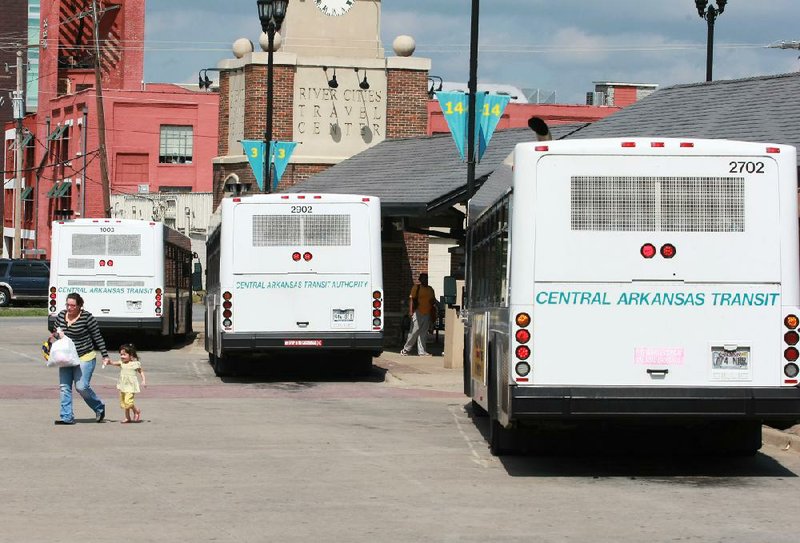The harsh weather central Arkansas endured last winter is still affecting the ridership numbers of the region's mass transit system.
But an analysis of the Central Arkansas Transit Authority's 5 percent drop in the number of passengers this year also suggests some of the decline reflects changing demographics and development along some of its routes.
At the same time, the top agency official said it would be difficult to adjust routes without falling off the "tightrope" on which the agency must balance itself.
CATA now relies on contributions from Pulaski County and the cities it serves -- nearly $12 million in 2013. The agency also collects about $2.2 million a year in fares and receives about $2.7 million annually from the federal government.
Under the current agreement CATA has with the county and cities, the agency has limited authority to make route changes because those changes can alter the funding formula, requiring some entities to pay less and some to pay more.
Furthermore, the agency has a responsibility to deliver its services to areas where the population relies on it.
"We know we need to support these extremely important neighborhoods," Jarod Varner, the agency's executive director, said in an interview last week. "What happens if their accessibility is removed?"
At the same time, the transit agency has to be "efficient," he said. Balancing accessibility and efficiency, therefore, "is a tightrope."
The ridership review, which came at the request of CATA board member Bentley Wallace, comes as the agency is undergoing a strategic review of its operations.
Nelson/Nygaard, a national planning consultant company focusing on transit, is developing the strategic plan to help develop better service options beyond the agency's traditional bus routes, analyze CATA's finances and look at possibly rebranding the agency.
Nelson/Nygaard has a contract that will not exceed $350,000, 80 percent of which will come from federal transit planning money.
Supporters of the effort, including some on the CATA board, said it could lead to a campaign for a dedicated tax, though alternatives also will be considered, including allowing the agency more autonomy to modify routes.
Through the first eight months of the year, ridership on CATA's fixed routes totaled 1,563,369, according to agency figures. The total represented a 5.22 percent decline from the same time period in 2013, when 1,649,446 passengers rode on the agency's buses.
The figures don't include ridership on the River Rail trolley system or LINKS, which is a service that provides point-to-point rides for people with disabilities.
A factor in the decline was the harsh winter weather the region endured earlier this year, according to Varner and the separate route-by-route analysis.
The system suffered three days when it didn't run at all, Varner said. At least two other days, the system had only limited service because of snow or ice.
"We lost about 10,000 passengers a day for those three days," he said.
There doesn't have to be snow or ice to depress ridership, Varner added.
In July, the latest month for which passenger figures were available, 232,335 riders boarded CATA buses, or 2.72 percent fewer than the 238,840 riders the agency saw in July 2013.
That decline was attributed, in part, to five rainy days that month, according to Varner.
"Our riders are pedestrians and cyclists," he said. "They are less likely to make discretionary trips during inclement weather."
Still, an analysis performed by the agency's transit planner, Matthew Long, did detect some softness in the ridership that is attributable to more than the weather.
A route that began in February 2013 -- Route 9 West Central/Barrow Road -- is the lowest-performing among CATA's 36 routes, with just 4.24 passengers per hour, a figure that Varner blamed on "lack of frequency."
A separate report by Nelson/Nygaard that looked at ridership in October noted that the frequency of stops on the route was once every 60 minutes, which was double what most other routes had scheduled.
Other routes, mainly in the central, east and south areas of Little Rock, saw declines that were attributed to loss of population and housing stock or a decline in jobs or other economic generators.
For instance, the analysis for Route 8 East Ninth said a decline it has experienced may be due to "the loss of homes in the Eastgate community and the closing of an industrial plan.
"In addition, the route serves an area in significant decline with very little commercial or retail trip generators and in a residential area with an aging population and housing units deteriorating or vacant."
But Varner said the soft ridership numbers also reflect what the strategic plan is ultimately expected to address when it is completed within the next eight to 10 months.
"It's mostly weather, but we are still seeing minor decreases in ridership," he said, adding that the transit system, as it is set up now, "is not workable for enough people. It lacks frequency and availability."
Metro on 09/02/2014
